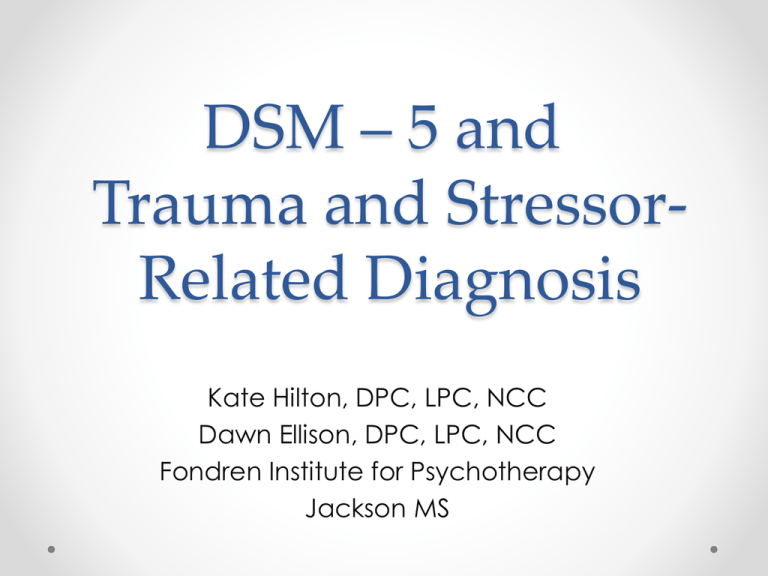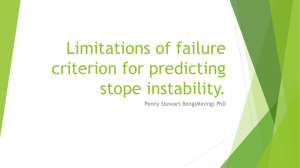DSM * 5 and Trauma Related Diagnosis
advertisement

DSM – 5 and Trauma and StressorRelated Diagnosis Kate Hilton, DPC, LPC, NCC Dawn Ellison, DPC, LPC, NCC Fondren Institute for Psychotherapy Jackson MS Trauma in the DSM • In layman’s terms, trauma typically refers to both the event that produces distress and the ensuing distress in an individual (Briere & Scott, 2006) • PTSD diagnosis presupposes exposure to traumatic event • What counts as a traumatic event? o DSM-III—combat, violent assault, natural disasters (outside the range of usual human experience) o DSM-III-R—expanded to include learning about or witnessing friend or family member exposure to lifethreatening event DSM-IV Defines a traumatic event as: • Involving actual or threatened death or serious injury or threat to one’s physical integrity (self or other) • Witnessing or learning about event • Subjective feeling of intense fear, horror or helplessness • Sudden and unpredictable • Shocking in nature (APA, 2000) DSM-5 • Traumatic event is described as exposure to actual or threatened death, serious injury, or sexual violence • Adds experiencing repeated or extreme exposure to aversive details of the traumatic event (collecting human remains; police officers repeatedly exposed to details of child abuse) • Specifies repeated exposure is not through electronic media, television, movies, or pictures– unless exposure is work related (APA, 2013) • Developmentally inappropriate sexual experiences without physical violence or injury (children) PTSD in the DSM • Specific diagnostic syndrome related to posttraumatic symptoms emerged in publication of DSM-III (APA, 1980) • Debilitating effects of war experience (Vietnam)— paralleled symptoms of victims of other forms of severe trauma (rape, natural disaster) • Reactions were unique symptom profile not captured by mood or anxiety disorders • Post-Vietnam syndrome became PTSD (North, Suris, Davis & Smith, 2009) Trauma & Stressor Related Diagnoses Posttraumatic Stress Disorder Acute Stress Disorder Adjustment Disorders Reactive Attachment Disorder Disinhibited Social Engagement Disorder Other Specified Trauma- and Stressor-Related Disorder • Unspecified Trauma- and Stressor-Related Disorder • • • • • • PTSD in DSM IV Criterion A1: Person experienced/witnessed/confronted with event where there was threat of or actual death/serious injury. May also have involved a threat to physical well-being. Criterion A2: Person responded to event with fear, anxiety, helplessness, or horror. Criterion B: 1or more re-experiencing symptoms: • Frequently upsetting thoughts or memories about a traumatic event. • Recurrent nightmares. • Acting/feeling as if traumatic event were happening again “flashback.” • Distress when reminded of the traumatic event. • Physically responsive (high heart rate or sweating) to reminders of the trauma. PTSD in DSM IV Criterion C: 3 or more avoidance symptoms • Avoid thoughts, feelings, conversations about the trauma. • Avoid places or people that remind you of the trauma. • Have difficult time remembering important parts of the trauma. • A loss of interest in important, once positive, activities. • Feeling distant from others. • Difficulties having positive feelings, such as happiness or love. • Sense of foreshortened future. Criterion D: 2 or more hyperarousal symptoms • Having a difficult time falling or staying asleep. • Feeling irritable, having anger outbursts. • Having difficulty concentrating. • Feeling constantly “on guard” or like danger is lurking around every corner. • Being “jumpy” or easily startled. Criterion E: Duration is more than 1 month Criterion F: Interferes with social, occupational or other areas of functioning PTSD in DSM-5 • PTSD was removed from anxiety disorders • Criterion A2 (response involves “fear, helplessness, or horror”) removed from DSM-5 • 3 clusters are divided into 4 clusters in DSM-5 o o o o Avoidance Re-experiencing Persistent negative changes in mood and cognition Arousal • 3 new symptoms were added • Other symptoms revised to clarify symptom expression • Separate diagnostic criteria for “preschool” (children 6 years or younger) • New dissociative subtype for PTSD added PTSD in DSM-5: CHANGES TO CRITERION A Criterion A1 is expanded: Trauma involves actual or threatened event, including: • Death • Serious injury • Sexual violence Four types of exposure • Directly experienced • Witnessed • Learned happened to a loved one (must be accidental or violent) • Repeated, extreme exposure to details (first responders, police – media exposure doesn’t count) Criterion A2 (Person responded to event with fear/anxiety/ helplessness/horror) is removed. PTSD in DSM-5: CHANGES TO CRITERION B Criterion B (intrusion) has: • Exact same 5 symptoms. • Endorse at least 1 B1: Memories • Versus DSM-IV recollections (images, thoughts, perceptions) B3: Flashbacks • Emphasis on dissociation and continuum of reactions Note: In children look for repetitive play/ trauma specific renactment PTSD in DSM-5: CHANGES TO CRITERION C CRITERION C: Avoidance • Numbing separated from avoidance (moved to D). • From 7 symptoms to 2 symptoms; endorse at least 1 o C1: Avoid memories, thoughts, feelings o C2: Avoid external reminders • Addresses problematic ambiguity in DSM-IV • “Conversations” moved from C1 to C2 to create clear distinction between internal and external stimuli PTSD in DSM-5: CHANGES TO CRITERION D CRITERION D : Negative alterations in cognition and mood • Endorse at least 2 • Numbing symptoms from DSM-IV plus two new symptoms • D1: Amnesia (not due to TBI or intoxication) • D2:Negative beliefs (broader version of previous “foreshortened future” symptom) • D3: Distorted cognitions and blame (from cognitive model of PTSD – think “stuck points”) • D4: Negative emotions (fear, horror, anger, guilt, shame) • D5: Diminished interest • D6: Detachment or estrangement • D7: Inability to experience positive emotions PTSD in DSM-5: CHANGES TO CRITERION E-H CHANGES TO CRITERION E: Arousal and Reactivity • Used to be hyperarousal cluster (Criterion D) • Endorse at least 2 • Similar to DSM-IV but with one new symptom: • E1: Irritable behavior and angry outbursts • E2: Reckless or self-destructive behavior (new emphasis on behavior). Ex: reckless driving, excessive alcohol use, suicidal behavior • E3: Hypervigilance • E4: Exaggerated startle • E5: Problems with concentration • E6: Sleep disturbance PTSD in DSM-5 CHANGES TO CRITERIA F-G: None F. Duration is more than 1 month G. Clinically significant distress or impairment Added Criterion H: H. Not attributed to the physiological effects of a substance or other medical condition. Specify • With dissociative symptoms • With delayed expression – 6 months post event Preschool Subtype: 6 Years or Younger Criterion A. In children (younger than 6 years), exposure to actual or threatened death, serious injury, or sexual violence, as follows: • 1) Direct exposure • 2) Witnessing, in person, (especially as the event occurred to primary caregivers) Note: Witnessing does not include viewing events in electronic media, television, movies, or pictures. • 3) Indirect exposure, learning that a parent or caregiver was exposed Preschool Subtype: 6 Years or Younger • Criterion B –1 (or more) symptoms o Intrusion symptoms may display as… • Play reenactment may not appear distressing • Dreams- content may not be related to trauma • Criterion C – 1 (or more) symptoms o Avoidance symptoms o Alteration in cognitions or mood o Preschool does not include: amnesia; foreshortened future; persistent blame of self or others; reckless behavior • Criterion D – 2 (or more) symptoms o Arousal symptoms o Extreme temper tantrums Preschool Subtype: 6 Years or Younger • Criterion E – Duration more than 1 month • Criterion F – Clinically significant distress /impairment • Criterion G – Not due to medical condition / medication • Specifiers: o Dissociative symptoms • Depersonalization • Derealization o Delayed onset • Criteria not met until 6 months after event Dissociative Subtype of PTSD New subtype for both age groupings of PTSD diagnosis: • Meets PTSD diagnostic criteria • Experiences additional high levels of depersonalization or derealization • Dissociative symptoms are not related to substance use or other medical condition Trauma- and StressorRelated Disorders Posttraumatic Stress Disorder Acute Stress Disorder Adjustment Disorders Reactive Attachment Disorder Disinhibited Social Engagement Disorder Other Specified Trauma- and Stressor-Related Disorder • Unspecified Trauma- and Stressor-Related Disorder • • • • • • Acute Stress Disorder in DSM IV A. PTSD A Criterion • A1 & A2 symptoms B. Dissociative symptoms (3 or more) • 1. Numbing, detachment, & emotional responsiveness • 2. Reduction in awareness (“dazed”) • 3. Derealization • 4. Depersonalization • 5. Dissociative Amnesia ASD in DSM IV • • • • • • C. 1 or more PTSD Intrusion Symptoms D. 1 or more PTSD Avoidance Symptoms E. 1 or more PTSD Arousal Symptoms F. Clinically Significant Distress or Impairment G. Duration more than 2 days and less than 1 month H. Not due to other cause (Intoxication, medical condition, etc.) Changes to ASD in DSM-5 • Criterion A changes same as PTSD updates – A1 is clarified; A2 is deleted. • Criterion B – Person now must meet any 9 of the 14 symptoms from 5 categories: intrusion (4), negative mood (1), dissociation (2), avoidance (2), and arousal (5) o It was concluded that DSM-IV’s ASD criteria was too heavily focused on dissociation; dissociation is no longer required for diagnosis. • No one symptom of the 14 is required for a diagnosis. Changes to ASD in DSM-5 • Criterion C – Duration 3 days to 1 month • Criterion D – Clinically significant distress / impairment (social, occupational, other) • Criterion E – Not due to substance or medical condition Trauma- and StressorRelated Disorders Posttraumatic Stress Disorder Acute Stress Disorder Adjustment Disorders Reactive Attachment Disorder Disinhibited Social Engagement Disorder Other Specified Trauma- and Stressor-Related Disorder • Unspecified Trauma- and Stressor-Related Disorder • • • • • • Adjustment Disorders in DSM-IV A. The development of emotional or behavioral symptoms in response to an identifiable stressor(s) occurring within 3 months of the onset of the stressor(s). B. These symptoms or behaviors are clinically significant as evidenced by either of the following: 1. 2. Marked distress that is in excess of what would be expected from exposure to the stressor Significant impairment in social or occupational (academic) functioning C. The stress-related disturbance does not meet the criteria for another specific Axis I disorder and is not merely an exacerbation of preexisting Axis I or Axis II disorder. D. The symptoms do not represent Bereavement E. Once the stressor (or its consequences) has terminated, the symptoms do not persist for more than an additional 6 months Specify if: Acute – less than 6 months Chronic – longer than 6 months Adjustment Disorders in DSM-5 • Re-conceptualized as a “heterogeneous array” of stress-responses • Similar to DSM-IV Criteria • Stressors are not necessarily traumatic o Ending of a romantic relationship o Business or marriage problems o Common developmental events Adjustment Disorders in DSM-5 • Criterion A – The development of emotional or behavioral symptoms in response to an identifiable stressor(s) occurring within 3 months of the onset of the stressor(s). • Criterion B – These symptoms or behaviors are clinically significant, as evidenced by one or both of the following: o Distress is out of proportion to the severity or intensity of the stressor • external context • cultural factors o Significant impairment in social, occupational, or other important areas of functioning. Adjustment Disorders in DSM-5 • Criterion C – The stress-related disturbance does not meet the criteria for another mental disorder and is not merely an exacerbation of a preexisting mental disorder. • Criterion D – The symptoms do not represent normal bereavement. o Conditions for Further Study - Persistent complex bereavement disorder • Criterion E – Once the stressor or its consequences have terminated, the symptoms do not persist for more than an additional 6 months. Adjustment Disorders in DSM-5 • Specify: o With depressed mood: Low mood, tearfulness, or feelings of hopelessness are predominant. o With anxiety: Nervousness, worry, jitteriness, or separation anxiety is predominant. o With mixed anxiety and depressed mood: A combination of depression and anxiety is predominant. o With disturbance of conduct: Disturbance of conduct is predominant. o With mixed disturbance of emotions and conduct: Both emotional symptoms (e.g., depression, anxiety) and a disturbance of conduct are predominant. o Unspecified: For maladaptive reactions that are not classifiable as one of the specific subtypes of adjustment disorder. Adjustment Disorders Fact Sheet • Common o 5-20% outpatient o 50% in inpatient • Risk factors o High rate of stressors • Culture matters • Comorbidity o Commonly accompany medical illnesses or disorders o Comorbid with any disorder as long as criteria are met o Associated with increased risk of suicide attempts and completion Trauma- and StressorRelated Disorders Posttraumatic Stress Disorder Acute Stress Disorder Adjustment Disorders Reactive Attachment Disorder Disinhibited Social Engagement Disorder Other Specified Trauma- and Stressor-Related Disorder • Unspecified Trauma- and Stressor-Related Disorder • • • • • • Reactive Attachment Disorder in DSM IV Categorized as disorders usually first diagnosed in infancy, childhood, or adolescence. A. Markedly disturbed and developmentally inappropriate social relatedness in most contexts beginning before age 5 years, as evidenced by: 1. 2. Failure to initiate or respond appropriately to social to contact Diffuse attachments A. B. C. Disregard of emotional needs Disregard of physical needs Lack of stable attachment B. Not accounted for by developmental delays C. Pathogenic care as evidenced by D. Criterion C is responsible for disturbance Specify if: o Inhibited o Disinhibited Changes in DSM-5 • Now two disorders: o Reactive attachment disorder o Disinhibited social engagement disorder • Based on two subtypes of reactive attachment disorder in DSM-IV o Emotionally withdrawn / inhibited o Indiscriminately social / disinhibited • Characterized by: o Social/emotional disturbance o Exposure to extremes of insufficient care Reactive Attachment Disorder in DSM-5 Criterion A – Consistent pattern of inhibited, emotionally withdrawn behavior toward adult caregivers, manifested by both of the following: • The child rarely or minimally seeks comfort when distressed. • The child rarely or minimally responds to comfort when distressed. Criterion B – Persistent social and emotional disturbance characterized by 2 or more of the following: • Minimal social and emotional responsiveness to others. • Limited positive affect. • Episodes of unexplained irritability, sadness, or fearfulness that are evident even during nonthreatening interactions with adult caregivers. Reactive Attachment Disorder in DSM-5 Criterion C – Child has experienced pattern of extremes of insufficient care as evidenced by 1 or more of the following: • Social neglect or deprivation in the form of persistent lack of having basic emotional needs for comfort, stimulation, and affection met by care-giving adults. • Repeated changes of primary caregivers that limit opportunities to form stable attachments. • Rearing in unusual settings that severely limit opportunities to form selective attachments. Criterion D –Care in Criterion C is presumed to be responsible for the disturbed behavior in Criterion A. Criterion E – The criteria are not met for autism spectrum disorder. Criterion F – The disturbance is evident before age 5 years. Criterion G – The child has a developmental age of at least 9 months Specify : • Persistent (more than 12 months) • Current Severity (ex: severe) Reactive Attachment Disorder Fact Sheet • Capacity for attachment is present, but opportunities in early life were scarce • Comorbidity o Developmental delays due to neglect (cognitive & language) o Depressive symptoms • “Relatively rare” even in populations of severely neglected children <10% Trauma- and StressorRelated Disorders Posttraumatic Stress Disorder Acute Stress Disorder Adjustment Disorders Reactive Attachment Disorder Disinhibited Social Engagement Disorder Other Specified Trauma- and Stressor-Related Disorder • Unspecified Trauma- and Stressor-Related Disorder • • • • • • Disinhibited Social Engagement Disorder in DSM-5 Criterion A –A pattern of behavior in which a child actively approaches and interacts with unfamiliar adults and exhibits at least two of the following: 1. Reduced or absent reticence in approaching and interacting with unfamiliar adults. 2. Overly familiar verbal or physical behavior (that is not consistent with culturally sanctioned and with ageappropriate social boundaries). 3. Diminished or absent checking back with adult caregiver after venturing away, even in unfamiliar settings. 4. Willingness to go off with an unfamiliar adult with minimal or no hesitation. Criterion B – The behaviors in Criterion A are not limited to impulsivity (as in ADHD) but include socially disinhibited behavior. Disinhibited Social Engagement Disorder in DSM-5 Criterion C – The child has experienced a pattern of extremes of insufficient care as evidenced by at least one of the following: 1. Social neglect or deprivation in the form of persistent lack of having basic emotional needs for comfort, stimulation, and affection met by caregiving adults. 2. Repeated changes of primary caregivers that limit opportunities to form stable attachments. 3. Rearing in unusual settings that severely limit opportunities to form selective attachments . Criterion D – The care in Criterion C presumed to be responsible for disturbed behavior in Criterion A. Criterion E – The child has a developmental age of at least 9 months. Specify: Persistent (more than 12 months) Current severity (ex: severe) Development in Disinhibited Social Engagement Disorder • Young ages o Fail to show reticence (reluctance) when interacting with strangers • Preschool o Attention seeking o Verbal & social intrusiveness • Elementary o All of the above o Inauthentic expressions of emotion • Adolescence o Extends to peers o Superficial relationships Disinhibited Social Engagement Disorder Fact Sheet • Neglect before 2-years old • Behavior violates the social boundaries of the culture • May co-occur with delays, or show signs of current neglect • May have a wide range of attachments from disturbed to secure • Unknown prevalence o Rare o Even in high-risk populations only 20% Implications • More helpful and specific treatment planning. • Research will increase and improve Trauma- and StressorRelated Disorders Posttraumatic Stress Disorder Acute Stress Disorder Adjustment Disorders Reactive Attachment Disorder Disinhibited Social Engagement Disorder Other Specified Trauma- and Stressor-Related Disorder • Unspecified Trauma- and Stressor-Related Disorder • • • • • • Other Specified Traumaand Stressor-Related Disorder • Symptoms cause clinically significant distress or impairment in functioning, but full criteria for another disorder in this category is not met. • Examples: o Adjustment Disorder with delayed onset (3 or more months after the stressor) o Adjustment Disorder lasts more than 6 months without prolonged duration of stressor o Conditions - Persistent complex bereavement disorder o Other cultural syndromes (Glossary of Cultural Concepts of Distress) Unspecified Trauma- and Stressor-Related Disorder • Symptoms characteristic of a trauma- and stressorrelated disorder that cause distress/impairment, but do not meet full criteria for other disorders in this class. • Use this diagnosis for situation when you do not want to, or cannot, specify the reason(s) that criteria are not met for another disorder. o Ex: When there is not enough information to make a more specific diagnosis (due to a short consult, emergency room visit, etc). Differences • Other-Specified o The clinician chooses to communicate the specific reason o Should always be accompanied by a reason • Unspecified o Clinician chooses not to specify o Is never accompanied by a reason o Insufficient information (Ex: Emergency room) Trauma- and StressorRelated Disorders Posttraumatic Stress Disorder Acute Stress Disorder Adjustment Disorders Reactive Attachment Disorder Disinhibited Social Engagement Disorder Other Specified Trauma- and Stressor-Related Disorder • Unspecified Trauma- and Stressor-Related Disorder • • • • • • Related Diagnoses “Placement of this chapter reflects the close relationship between these diagnoses and disorders in the surrounding chapters on… o Anxiety o Obsessive-compulsive and related o Dissociative Disorders” References American Psychiatric Association. (2014). Changes in DSM-5. Retrieved from http://www.dsm5.org American Psychiatric Association. (2013). Diagnostic and statistical manual of mental disorders (5th ed.). Arlington, VA: Author. Courtois, C. A. (2013). PTSD in the DSM-5. Retrieved from www.drchriscourtois.com. Friedman, M. J. (2013). Trauma and stress-related disorders in DSM-5. National Center for PTSD. Sweeton, J. (2014). DSM-5: Trauma-and stressorR=related disorders: Criteria, changes, and clinical implications. Oklahoma City: VA Medical Center








